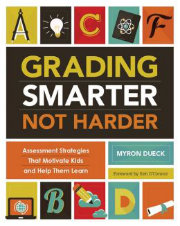Grading Smarter Not Harder Is Liberating
Grading Smarter, Not Harder: Assessment Strategies That Motivate Kids and Help Them Learn
By Myron Dueck
(ASCD, 2014 – Learn more)

This summer I was asked to attend the Assessment Training Institute by my principal. Our district has been building on a balanced assessment initiative for the last few years and I was eager to learn. My personal philosophy on grading was shifting. Saddled with “no late work” policies that no longer made sense to me, I tried to discern where “fairness” was in the middle of all this change.
Myron Dueck’s new book, Grading Smarter Not Harder: Assessment Strategies That Motivate Kids and Help Them Learn not only explains what is fair, but provides the teacher and student friendly strategies to achieve it. Dueck’s book is the map for your assessment journey.

Grading
In his first chapter, Dueck challenges teachers to separate behaviors from academics. Learning outcomes must drive grading. He reminds us of what we already know – that “behaviors result in their logical consequences.” Making deductions for late assignments and giving zeros for missing work are punitive measures based on behavior.
Dueck argues that “penalties should be just, reasonable, and linked as closely as possible to the offense.” We as teachers know the power of the zero to rob our students of the opportunity to make a change. Dueck offers these strategies for grading: use incompletes and interventions instead of zeros; institute two-tiered testing, and match consequences to behaviors.
Homework
Dueck discusses the problems associated with grading homework, including confusing completion with understanding, promoting busy work, inflating and deflating grades, perpetuating extrinsic dependency, and perpetuating the disadvantages for low-income students.
To make homework meaningful, Dueck suggests four strategies: give in-class quizzes, develop individual homework profiles, provide in-school support and try flipping your classroom to provide support to those who need it most. For these strategies to be successful, look for team or building support, strengthen relationships with your parents, and offer enrichment for those who need it.
Unit Plans
This is my favorite chapter. About four years ago I started to use simple unit plans that listed the objectives for the unit. The objectives have become learning targets that are explained to students through “I can” statements. All of this is suggested by Dueck in his chapter on unit plans, but of course he takes it a couple of steps further. And that is because of the “trouble with surprises.” He comments,”Unit tests should measure student learning explicitly covered in class.” This makes so much sense.
Students need a road map. Strategies should include student-friendly unit plans aligned to the test. The teacher then needs to use the plan throughout the unit. Refer back to it frequently and include the assignments by learning target along with examples of student work. And remember “you should only grade what you are asked to by learning standards.” Amen.
Retesting
Traditional classroom tests have a slew of problems. The most obvious problem is that they are seen as the final word on learning, when in truth a test is a ” snapshot in time.” They discourage mastery and ignore the learning that takes place “during testing.” Dueck reminds us, though, that there are also problems with retesting. Students may need to retake the entire test. Retesting takes time, provides little valuable data, and it may not reflect authentic learning.
Dueck suggests these strategies to deal with those problems: Customize the retest for each student. Double-dipping is a clever idea. Plan your quizzes to match the test; that is, use the same number of questions so the student can use a better test score on that section to replace the quiz score.
Another suggestion I found particularly helpful is to allow the student to respond in a variety of ways. “Every student has the opportunity to fully meet …the outcomes.” Ding dong, the bell curve is dead. Or it should be.
Creativity
My experience has been that students love having permission to be creative. Even if that permission is simply a choice of questions. When creativity becomes a major component of an assignment, I have stumbled with grading that creativity. While creativity increases engagement and motivation, according to Dueck, there are potential problems to using it in the classroom.
Creativity can be unpredictable and distracting from intended learning (which is always the focus). It can inflate grades for the artistically minded and deflate grades for at-risk students. The search for resources can take students outside of teacher control. And there’s my biggest problem – how do you assess?
Dueck provides realistic guidance for grading creativity. First provide a project planning sheet. Recognize creativity without grading it. Remember, grade only the learning that takes place. If your standards allow it, measure creativity with a rubric (and he provides one).
Here’s an interesting strategy. Ask for student feedback on the test format to inform your creativity. And I LOVE this last one! Use the “I know I am close…” response. You really need to read the book to understand this one, but it allows the student to explain their reasoning when they cannot decide between two multiple choice responses
Don’t forget to add a little modern technology to the creative mix. Try Twitter, digital pictures, apps, and Google docs. Just remember, if these projects are group projects, find a way to assess the students individually.
Dueck says it is “exciting” to realize your grading practices are based on untruths. I would rather use the word “liberating.” Once I get past the dissonance, I am encouraged by the responses I see from my students. When a student tells me, “I have never done this well in social studies before,” I know I have found the right “map” for my assessment journey.
Joanne Fuchs is in her 15th year of teaching. A 7th grade world history teacher, she is also the lead teacher for her department and a member of the curriculum writing committee. A member of her district professional development committee, she is also actively developing her PLN through chats on Twitter (@geojo22) and attending edcamps. Inquisitive by nature, Fuchs is always ready to learn and hopes her passion for learning wears off on her students and colleagues.






























This is the author addressed in our building PD at Swartz Creek Middle School, Looks like an interesting read.